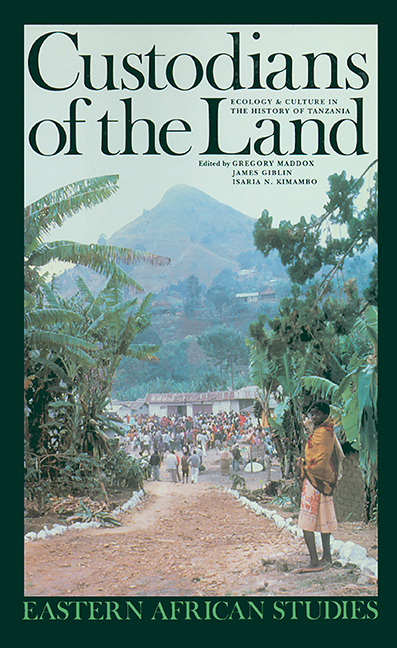Book contents
- Frontmatter
- Contents
- List of Maps, Figures & Tables
- List of Photographs
- Abbreviations
- Contributors
- Acknowledgements
- Introduction Custodians of the Land: Ecology & Culture in the History of Tanzania
- Part One Environmental & Demographic Change
- Part Two Environmental Change & Economic History: In Tanzania's Northern Highlands
- Part Three Politics & Environmental Change
- Part Four Environment & Morality
- Conclusion
- Bibliography
- Index
Part One - Environmental & Demographic Change
Published online by Cambridge University Press: 30 August 2017
- Frontmatter
- Contents
- List of Maps, Figures & Tables
- List of Photographs
- Abbreviations
- Contributors
- Acknowledgements
- Introduction Custodians of the Land: Ecology & Culture in the History of Tanzania
- Part One Environmental & Demographic Change
- Part Two Environmental Change & Economic History: In Tanzania's Northern Highlands
- Part Three Politics & Environmental Change
- Part Four Environment & Morality
- Conclusion
- Bibliography
- Index
Summary
Demography provides one of the most important connections between environmental change and political economy. In this part, Juhani Koponen and Gregory Maddox argue that demographic conditions are closely related to economic structures. In later parts, several essays complete the chain of causation which links political and economic with environmental change. For example, James Giblin's study of Handeni shows that highly localized increases in population density allowed improvement in control of the disease environment, but that demographic reversals meant a worsening of the disease situation. Similarly, the essays on mountain regions by Pamela Maack and Thomas Spear describe the consequences of population growth in highland environments, which in some places included soil erosion, soil exhaustion, parcelling of land and overgrazing. They also demonstrate that environmental deterioration intensified political tensions both between highlanders and the colonial government and within highland communities themselves. However, Jamie Monson finds a much more direct connection between political economy and environmental degradation in the Kilombero Valley, for she shows that forest conservation policies, which forced farmers to overwork soils in areas which remained outside forest reserves, grew out of a complex set of political and economic considerations.
Thus by investigating the causes of demographic growth in the colonial period, Koponen and Maddox contribute to an understanding of the close connection between environmental change and political economy, which is the chief concern of this volume. In so doing, however, they find it necessary to revise the conventional chronology which takes the colonial conquest to have been the decisive turningpoint in Tanzanian history. In particular, they challenge the chronology of demographic change presented by Helge Kjekshus, who regarded the beginning of the colonial period as the point of transition between two demographic regimes. Kjekshus argued that, whereas the precolonial period had witnessed gradual population increase, colonial conquest brought dramatic population decline. In contrast, Juhani Koponen, in a chapter which surveys an extensive body of demographic evidence from the entire territory of mainland Tanzania, argues here that a prolonged period of population decline spanned both the final precolonial decades and the early colonial period. The critical transition to demographic recovery occurred, he believes, between the First and Second World Wars. Maddox attempts to identify the moment of demographic transition even more precisely in a chapter which focuses upon the region of Dodoma. He contends that Dodoma experienced sustained population growth only from the mid-1950s.
- Type
- Chapter
- Information
- Custodians of the LandEcology and Culture in the History of Tanzania, pp. 15 - 18Publisher: Boydell & BrewerPrint publication year: 1996

